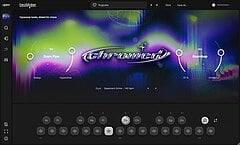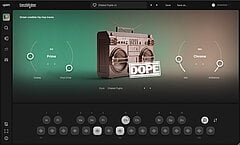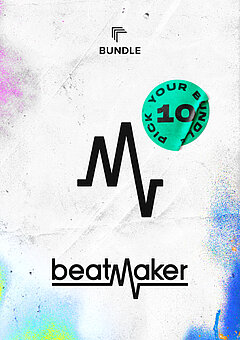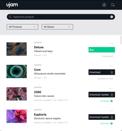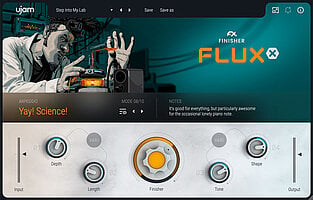The Life of a Beatmaker: Camoflauge Monk in the Lab
Camoflauge Monkis one of the core producers behind Griselda — the Buffalo-based hip-hop collective known for its grimy, sample-heavy sound and raw lyricism. If you’ve listened to Westside Gunn, Conway the Machine, or Benny the Butcher, chances are you’ve heard Monk’s lo-fi, soul-chopping magic in action.
JUNE 20TH, 2025
At UJAM, we’re suckers for creators who skip the rulebook and trust their ear. Monk’s studio setup is a vibe in itself: FL Studio, a PlayStation 1 running MTV Music Generator, and a handful of character-rich plug-ins — including a few of ours. No boutique consoles. No velvet ISO booths. Just raw intuition, dusty soul loops, and beats that slap — even when they’re made during a Buffalo blizzard.
He hopped on a call between beat packs, Dropbox links, and existential dread (“I feel like quitting right now, lol”). Below is the good stuff, stitched together so you can binge-read it in the time it takes him to drag-n-drop a snare, mute it, and decide silence hits harder.
Bedroom Experiments, PlayStation Strings
The first Camoflauge Monk beats emerged from a bedroom PC running FL Studio and, improbably, a PlayStation loaded with MTV Music Generator.
At first, it was all about trial and error: chopping loops, experimenting with sounds, and trying to turn raw ideas into something real.
“I didn’t ‘find my voice, I just stopped trying to sound like anybody else.”
That voice came later, once he stopped trying to emulate others and leaned into his own instincts. Trusting his ear became the turning point — the moment his style started speaking for itself.
Those early tools remain at the heart of his setup. He could afford better gear now, sure, but every upgrade risks crowding out the looseness he values most.
“I learned early that less usually wins,” he says. “If the loop moves me, I leave it alone. Over-thinking kills vibe faster than cheap speakers do.”
The Buffalo Weather Report
Buffalo isn’t an easy city to romanticize. Winters are long, industries thin, and the national spotlight only arrives when snow totals break a record. Yet Monk credits the city’s rawness for the tonal honesty in his beats.
“You get resilience here,” he says. “It’s gritty, no shortcuts, and that shows up in the music. Buffalo taught me to keep pushing, even when nothing’s easy.”
Sometimes that resilience wavers; Monk admits he debates quitting “pretty much every week.” But when life crowds in, music pulls him back. Making beats is therapy, he explains, a way to transmute frustration into something that thumps.
A Direct Message That Changed the Timeline
The origin story is simple, but legendary in Griselda circles: Camoflauge Monk tweets at Westside Gunn, Gunn replies, and a Dropbox link turns into a beat placement on Hall & Nash and Hitler Wears Hermes. Minimalist, gritty, and unmistakably Monk.
What made that digital handshake stick? Mutual respect. “He trusted my sound, and I trusted his vision,” Monk recalls. In the studio they discovered an unspoken language: Monk leaves breathing room; Gunn fills it with ad-libs and baritone swagger. The relationship grew from file-sharing to real-time collaboration, each pushing the other further into sparse extremes.
Sculpting Silence
Plenty of producers can make a beat “knock.” Monk wants his to haunt you after they end. He’s allergic to over-arranging; every instrument must earn its space, anything that might clash with a rapper’s flow gets dialed back or cut entirely.
“I always ask, ‘Will this still feel alive if the drums vanish?’ If the answer’s no, the idea’s not ready.”
That philosophy shapes everything from his sample choices—slivers of soul, stray organ chords, mouth-harp loops warped until they sound extraterrestrial, to his use of plug-ins. ShaperBox and a couple of UJAM titles colour the edges, but never dominate the canvas. Digital precision meets analog warmth, yet neither side wins outright; the track breathes in the tension.
Gear, But Not Too Much
Monk works on a pair of monitors, FL Studio, the PlayStation relic, and a short list of plug-ins he knows inside-out. He laughs at the idea of designing every kick drum from scratch: “Who has time? Damon Albarn used a Casio preset on a hit record. I’m good.”
The modest rig isn’t an aesthetic flex; it’s survival. Television deadlines and Griselda drop-dates don’t leave room for recall nightmares or boutique troubleshooting. Monk’s system is fast, stable, and brutally honest—if a loop sounds good there, it’ll sound good anywhere.
Looking Ahead: Risk or Rust
Talk to Monk for more than five minutes and you’ll hear the unease many creators feel in 2025: AI-generated loops, trend-chasing producers, playlists calibrated by algorithms. He’s not panicked, but he is clear-eyed.
“AI can copy formulas all day,” he says. “What it can’t fake is the moment you mute a hi-hat and everyone in the room knows why you did it.”
His advice to new beatmakers echoes that conviction. Forget gear lists, Instagram beats-per-day challenges, and whatever the discover page insists is hot. Curate your ears, absorb everything, and then let your own instincts decide what stays. One risky, personal loop will travel further than a dozen safe ones.
Monk’s Mindset, Beatmaker’s Workflow
Camoflauge Monk’s whole philosophy is about trusting your instincts, not overloading your setup. That’s exactly what Beatmaker 3 is made for:
A focused browser, instant load times, and just enough control to shape your sound without killing the vibe.
If your best ideas come from deleting hi-hats, dragging in loops, or just letting things breathe — Beatmaker 3 is your kind of tool. No distractions. Just flow.
Final Fade
Camoflauge Monk’s catalogue is proof that minimal doesn’t mean small, and lo-fi doesn’t mean careless. It means discipline, intuition, and the nerve to let silence sit in the mix until it becomes its own instrument.
So close this tab, crack open your DAW (whatever version, whatever rig) and try deleting half the track instead of adding a new plugin. Buffalo’s finest is betting you’ll hear the difference in the quiet.
Stay up to date
Sign up and we’ll send you an e-mail with product news and helpful stuff every now and then. You may unsubscribe at any time.
Defy Limits
We develop software solutions that enable people to create, consume and interact with music.

